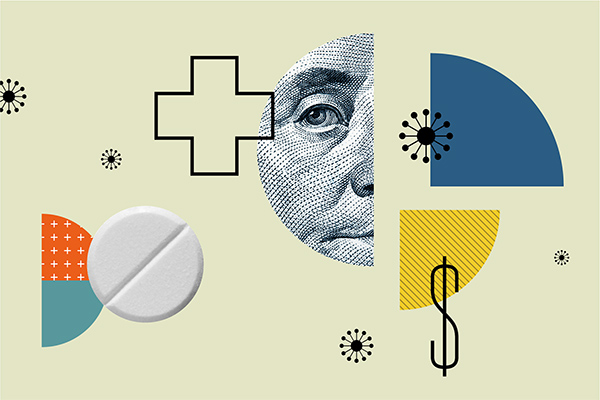What the Coronavirus Means for the Future of Financial Planning

Just five short months after its abrupt slide into bear-market territory at the outset of the pandemic, U.S. stock market indexes had fully regained their lost ground and begun to scale new highs by late August 2020.
But the market’s speedy recovery is dissonant with a still-struggling economy. The U.S. unemployment rate remains stubbornly high, and U.S. gross domestic product growth is expected to post a steep decline for the year. In an effort to avoid stamping out signs of an economic recovery prematurely, Federal Reserve chairman Jerome Powell announced in late August that the Fed would be more tolerant toward inflation, leaving interest rates low even if inflation runs above the Fed’s previous target of 2%.
In addition to wreaking havoc on the economy at large, the pandemic has had sudden and significant repercussions for how individuals conduct their financial planning—specifically, how they approach spending and saving goals.
Many households have experienced income shocks and have burned through their cash reserves, illustrating the critical role that liquid assets play in the health of any financial plan. Other workers have experienced health challenges at the same time they’ve experienced income reductions or outright job losses, underscoring the challenges of a system that tethers health-insurance coverage to employment and highlighting the importance of factoring healthcare outlays into a total financial plan.
The pandemic’s economic side effects also have significant implications for when and how older adults plan their retirements. Not only have older workers experienced some of the highest rates of job loss of any age band, but in previous recessions, it has also taken older unemployed workers a much longer time to become re-employed than younger ones. That, plus the fact that a recovering stock market has lifted retirement account balances, has no doubt prompted some to ponder early retirement. Yet low interest rates—while a boon to borrowers—are a headwind for people nearing or in retirement.
All of these trends have implications for the way households—and the advisors who assist them—manage their finances. While the COVID-19 crisis has brought these topics to the forefront, their importance is likely to persist post-pandemic as well.

How the Pandemic Has Impacted Financial Planning for Emergencies
The economic shock related to the pandemic illustrates, yet again, the importance of emergency reserves as part of a financial plan and the difficulties that many individuals and households face in amassing these “rainy-day funds.”
Lower-income households, not surprisingly, are the least well equipped to handle financial emergencies: In a Pew Research survey conducted in April 2020, just 23% of lower-income households said they had an emergency fund sufficient to tide them through three months of job loss.
But the lack of short-term financial wherewithal isn’t limited to lower income tiers. More than half (52%) of middle-income households in the Pew survey said they didn’t have enough savings to cover three months’ worth of living expenses, and 25% of upper-income people said they didn’t have three months’ worth of reserves.
In an effort to help individuals affected by COVID-19 access cash, the CARES Act was signed into law in late March. This act enables COVID-affected individuals to take up to $100,000 from their IRAs and 401(k)s without the additional 10% penalty that normally applies to early withdrawals. Taxes on those withdrawals still apply, but the provision also allows such individuals to pay those taxes, and pay back the withdrawn funds, over a three-year period.
However, it’s still a wise practice to have an emergency fund separate from long-term 401(k) assets. Withdrawing from retirement accounts is suboptimal because those withdrawn funds can’t benefit from market appreciation—imagine, for example, the worker who liquidated stocks from a retirement account in late March 2020, only to miss the subsequent recovery.
Plus, an emergency fund can boost peace of mind and financial confidence in long-term goals. In a report conducted by AARP, people with emergency funds felt 2.5 times more confident in their ability to achieve their financial goals than those who did not.
Financial advisors can play a role in helping clients set a savings goal for these emergency funds based on factors like their employment status (contract or permanent), variability of earnings, number of earners in the family, and so on.
- Gig economy and contract workers are naturally at risk for more frequent and longer work interruptions than permanent workers and therefore should prioritize building emergency funds larger than the standard benchmark of three to six months’ worth of living expenses.
- Higher-income workers and/or those with more specialized career paths should also target larger emergency funds, because such positions typically take longer to replace than lower-income, less specialized jobs.
- Dual-income households arguably need less of an emergency reserve than single-earner households, because the probability of both earners facing job loss at once is less than it is for single earners.
Advisors can also help clients determine where to hold their emergency funds. While a nonretirement brokerage account is the simplest holding place for short-term cash needs, other vehicles can fit the bill.
- A Roth IRA can serve as a multitasking vehicle, especially for younger investors. In a best-case scenario, the Roth assets would remain undisturbed until retirement. But in a financial crunch, the account owner can withdraw his or her contributions (not investment earnings) without taxes and penalty at any time and for any reason.
- Health savings account assets can also be used in the emergency funds context—to pay healthcare expenses, obviously, but also to cover nonhealthcare expenses if the HSA owner had previously used non-HSA assets to cover healthcare costs. (There’s more detail on this strategy below.)
The fact that so many consumers struggle with amassing emergency reserves may also reignite interest among policymakers in allowing employers to offer so-called “sidecar” funds. The idea behind such funds, as advanced by academic researchers, would be for employees to contribute aftertax dollars automatically to an emergency fund. Once cash builds up to the employee’s own target, he could direct future pretax contributions to long-term retirement savings.
Automating these contributions through payroll deductions may make it easier for individuals to save than when they’re saving on a purely discretionary basis.

Rethinking Financial Planning to Manage Healthcare Costs
Somewhat counterintuitively, given that COVID-19 is first and foremost a health crisis, spending on healthcare actually declined substantially in the first quarter of 2020. That’s because both patients and hospitals deferred in-person nonemergency medical visits and elective procedures, as patients were fearful of the virus and hospitals needed to focus their resources on emergency COVID-19 care. In fact, nearly half of the decline in GDP in the first quarter of 2020 was attributable to reduced healthcare spending, and declines in healthcare spending were a key culprit in reduced consumer spending in the second quarter, too.
Nonetheless, the fact that a health crisis has spurred higher levels of unemployment points to the financial challenges posed by a system that tethers healthcare insurance coverage to work.
Financial advisors can help play a role in assessing options for healthcare in case of job loss or if the client’s employer doesn’t offer coverage.
Advisors can also assist clients who have multiple options for employer-provided coverage in identifying the best plan for their needs. While the percentage of employers who offer only high-deductible healthcare coverage has been declining, in part because the job market had until recently been tight, nearly two thirds of workers are currently employed by a company that offers both a high-deductible plan and a traditional health plan such as a preferred provider organization, according to a 2019 survey from the Kaiser Family Foundation.
When helping clients elect the best coverage, advisors should take into account premiums, healthcare usage and preferences, out-of-pocket expenditures like copayments, and the clients’ financial wherewithal to cover unanticipated healthcare outlays, among other key factors.
Advisors to people who are covered by high-deductible plans can also help them utilize and maximize their contributions to health savings accounts.
At a minimum, such accounts can serve as a tax-advantaged way to cover healthcare expenditures as they’re incurred, as contributions are made on a pretax basis and qualified withdrawals are also tax-free.
For clients who have the wherewithal to cover out-of-pocket expenses on an ongoing basis, the most tax-beneficial way to use an HSA is to invest it in long-term assets. In contrast with flexible spending arrangements, where funds must typically be spent in the same year in which they’re contributed, HSA assets can be invested in long-term securities like stocks or bonds and can remain in the account for as long as the investor wishes. That enables the funds to grow on a tax-sheltered basis and stretches out the long-term tax benefits.
In a worst-case scenario in which the client “oversaves” in the HSA, he or she can withdraw the funds after age 65 and use them for any purpose; any amounts not used for qualified healthcare expenditures would be subject to ordinary income tax. In that case, the HSA functions much like a traditional IRA from a tax standpoint. The HSA carries no income limits, either, which makes it an excellent ancillary retirement savings vehicle for high-income investors. (Note that you cannot make additional HSA contributions once you’re covered by Medicare; you must be covered by a high-deductible plan.)
Triple Tax Benefits of HSAs
HSAs are the most tax-beneficial way to invest over the long term. Contributions are tax-deductible, growth is tax-free, and if they are used for qualified medical expenses, withdrawals are tax-free.Another way to use health-savings assets is to cover long-term care premiums, up to the IRS’ annual limits (which are age-based). In addition, investors who are using an HSA as a long-term savings vehicle, paying out of pocket for healthcare expenses, should be aware that the HSA can function as an ancillary emergency fund. That’s because HSA assets can be withdrawn on a tax-free basis for nonhealthcare expenses, provided the investor has receipts to substantiate healthcare expenses that were previously incurred and paid with non-HSA assets.
While high-deductible plans offered through employers are typically paired with an HSA, it’s important to note that the insured isn’t wedded to that HSA. It’s usually most expedient—and tax-efficient—to make contributions through payroll deductions to the HSA linked to the high-deductible plan. However, the participant can periodically transfer funds from the HSA to another HSA of his or her own choice.
As of Morningstar’s most recent Health Savings Account landscape report, Fidelity’s HSA was the most highly rated regardless of whether the investor was using it as a short-term or long-term savings vehicle. Advisors can assist clients not only in choosing the best HSA but also in helping them invest the HSA assets in a sensible way given the client’s usage. A client who is using the HSA to cover healthcare outlays as they are incurred, for example, should stick with conservative options like the savings account, whereas clients employing HSAs in a long-term context can reasonably target an equity-heavy HSA portfolio.
Finally, healthcare spending in retirement remains an important consideration. Morningstar research indicates that spending typically trends up later in retirement, after heading higher early in retirement and tapering off in the mid-retirement years—a valuable argument for amassing HSA assets. David Blanchett, head of retirement research for Morningstar Investment Management, calls this pattern the “retirement spending smile.”
While early-retirement spending is often driven by discretionary expenditures—travel and assisting adult children, for example—Blanchett’s research points to higher healthcare outlays as a major driver of higher spending for older retirees. Those outlays encompass uninsured long-term-care expenses, as well as prescription drug costs, among other expenditures.
Spending Smile
According to Morningstar research, retirees spend the most at the beginning and end of their retirement, the latter of which is driven by high healthcare costs.But how much can retirees expect to spend? Research conducted by Fidelity puts the lifetime in-retirement cost of healthcare for a 65-year-old couple at nearly $300,000, a figure that doesn’t include long-term care. Yet Vanguard research, conducted in conjunction with Mercer, points to significant variability in healthcare outlays in retirement.
Healthy people with supplemental policies incur out-of-pocket healthcare costs in the realm of $3,000 per year, on average, whereas less-healthy people without supplemental policies could easily pay more than double that amount. Income level, which in turn determines whether a retiree pays an extra premium for Medicare Part B and D coverage, also affects out-of-pocket expenses for high-income retirees.
Those extra premiums (Medicare’s Income-Related Adjustment Amounts, or IRMAA) kick in for single filers with more than $87,000 in income and joint filers with $174,000 in income. Older adults, especially those without long-term-care insurance, are also contending with the wild card of high out-of-pocket costs toward the end of life.
Advisors can assist their retired clients by helping them budget for healthcare expenditures based on their health histories, the presence of supplemental coverage, and whether IRMAA applies. Advisors can also serve a valuable role in helping retired clients source the funds for healthcare outlays.
To the extent that a retired client has HSA assets, for example, they should usually be spent during the client’s lifetime, because their tax benefits disappear when inherited by someone other than a spouse. If a client has extremely heavy healthcare outlays—as is typical when a long-term-care need arises—it’s usually desirable to spend those assets with heavy tax consequences. That’s because tax deductions for healthcare outlays can offset the taxes due on the withdrawals.

How Older Workers Can Approach Financial Planning for Potential Early Retirement
In addition to its impact on emergency savings and healthcare spending, the current economic crisis will likely have implications for retirement planning for many individuals. Contrary to the financial crisis of 2007-09, when older adults maintained higher levels of employment than younger cohorts, the COVID-19 crisis has thus far had a disproportionate effect on older workers. Workers age 55 and above have been one of the groups most impacted by job losses during the current pandemic, second only to younger workers under age 34. By contrast, workers between 35 and 54 have remained employed at relatively higher rates.
While some of these newly unemployed older adults may be assessing whether they can replace the jobs they’ve lost, a segment of them may also be mulling whether an early retirement is an option.
During the last recession, for example, adults ages 62 and older were the least likely age group to become reemployed once they lost their jobs, according to research conducted by the Urban Institute. Roughly a third found jobs within one year of becoming unemployed, and about 40% became re-employed within 18 months of the job loss. The study’s authors conjectured that the ability to take Social Security at age 62, albeit with a reduced benefit, likely prompted some of these individuals to end their careers earlier than they might have expected.
At the same time, it’s worth noting that early retirement isn’t exclusively a bear-market/recessionary phenomenon. Research conducted by Morningstar’s Blanchett concluded that workers often retire earlier than they expected to—about four years earlier, on average. The research found that while still working, the typical worker estimated retirement at age 66, whereas the actual average retirement date was 62.
Retirement Mirage
People on average retire earlier than they planned, putting pressure on their retirement portfolios to last longer. The pandemic may pressure older workers to retire sooner than they expected.But early retirement isn’t always in an individual’s best interest—rather, working even a few years longer than the traditional retirement age of 65 can be hugely beneficial to the health of a retirement plan, and early retirement can pose challenges to a plan’s sustainability. For instance:
- Early retirement can truncate opportunities for additional retirement-plan contributions, compounding, and tax deferral.
- Withdrawals over a longer time horizon can force a lower withdrawal rate or reduce the probability that the retiree’s funds will last over his/her time horizon.
- Early Social Security filing can result in reduced benefits over a retiree’s lifetime.
- People who retire early may also need to shoulder healthcare expenses until they’re Medicare-eligible.
Of course, the decision about when to retire is about much more than money. The employee’s own health and that of his/her family members, longevity considerations, the physical and mental strains of their job, and, of course, economic conditions may also be in the mix. But financial advisors can help their clients understand the trade-offs associated with early retirement, and in particular the stresses that may impact the viability of the financial plan.
Advisors can also assist early-retiree clients in mapping out a plan for sourcing in-retirement cash flows, including maximizing nonportfolio income sources like Social Security and making decisions about pensions, especially if the client’s employer has offered a lump-sum pension buyout.
For example, it’s often more beneficial to delay Social Security filing, even if it means expedited withdrawals from retirement accounts in the early years of retirement. Retirement withdrawals in low tax years may be less costly than those later in retirement, after required minimum distributions have started, and can also reduce the amount of the portfolio that will eventually be subject to required minimum distributions at higher tax rates.
And, importantly, delayed Social Security filing can enlarge eventual benefits, something that’s particularly important for married couples where the higher-earning spouse (who’s entitled to a higher Social Security benefit) is also older. In that instance, if the older spouse dies before the younger one, the younger spouse can continue to receive the higher benefit for the rest of his/her life, assuming it’s higher than the surviving spouse’s own benefit.
On the flip side, the pandemic’s drive toward remote work could make staying employed easier and more attractive for older adults who wish to continue working, are able to do so, and can take advantage of flexible work arrangements. For example, working longer may be more palatable if it doesn’t entail a commute or if the older worker can live where he or she eventually retires.

How Can You Accommodate Low Yields in a Financial Plan?
Finally, retirees of all ages—early or otherwise—have a huge challenge today in the form of very low bond yields, the result of Federal Reserve activity designed to ignite an economy that would otherwise be struggling even more amid the pandemic-related slowdown.
To be sure, low yields aren’t a complete negative for retirees’ financial plans. They’re a big plus for borrowers, a group that increasingly includes retirees: In a 2018 survey cited by AARP, 44% of people between the ages of 60 and 70 said they expected to be carrying a mortgage when they retire. Swapping into a lower-rate or shorter-term mortgage or buying a car with a very low or even 0% interest rate could reduce in-retirement expenses for many individuals. Moreover, the fact that safe securities yield so little today has contributed to the ascent of higher-risk assets, especially stocks.
But even as retirees have gained on one side of the ledger as yields have declined, they’ve lost on the other. Not only do low yields reduce how much retirees can wring from their safe investments, but yields are also predictive of what bonds are apt to return over the next decade. The Bloomberg Barclays Aggregate Index currently has an SEC yield of about 1.3%, suggesting that investors will barely break even assuming even modest levels of inflation.
Investors aren’t even able to find a bump in yields today when they venture way out on the risk spectrum—either by accepting more interest-rate sensitivity or credit risk—even though they are subject to a substantially higher level of volatility. Long-term high-quality bonds yield just over 2% today, whereas corporate bonds are yielding just over 3%. In other words, every rock has been turned over in search of yield.
Yields Predictive
There is a strong relationship between current bond yields and 10-year bond returns. Today’s low yields don’t bode well for long-term returns.These low yields constrain the return potential of portfolios that have an allocation to bonds and cash, at least for the next decade. That has implications for withdrawal rates, in that what’s considered sustainable over a retiree’s own time horizon depends completely on the returns of that portfolio’s constituent holdings. Assuming even a generous 2% return for fixed income and an equally generous 6% equity return, a 60% equity/40% bond portfolio would return just 4.4% over the next decade.
That suggests that new retirees, in particular, should be conservative on the withdrawal rate front, especially because the much-cited “4% guideline” for portfolio withdrawal rates is based on market history that has never featured the current combination of low yields and not-inexpensive equity valuations. Morningstar’s Blanchett and retirement researchers Michael Finke and Wade Pfau co-authored research in 2013 suggesting that low yields conspire against the viability of the 4% guideline. The equity market “bailed out” low yields over the past decade, but Pfau thinks the odds are stacked against 4% as a sustainable withdrawal rate for new retirees, especially given that starting equity valuations are not cheap. Below, we outline probabilities of success for different withdrawal rates over the course of retirement.
Retirement Withdrawals
Especially in a low-yield world, retirees will have a better chance of successfully funding their retirements if they eschew the 4% guideline and withdraw a smaller percentage.Initial Withdrawal Rate
In addition to highlighting the importance of maintaining a conservative withdrawal rate, very low yields on safe securities embellish the value of other options in retirement—notably Social Security and fixed-rate annuities. The benefit for delaying Social Security hasn’t changed despite lower yields coming online, making the value of waiting relatively more attractive today than it was a decade ago. Delaying Social Security isn’t right for everyone and doesn’t always deliver an 8% return, contrary to the frequent assertions that it does. But the payoff for waiting can be substantial, especially for people with longevity on their sides and/or younger spouses.
Meanwhile, the payout from fixed annuities depend in large part on current yields. That’s because the insurer might choose to invest in safe securities, which would affect how much income the products can deliver. That would seem to depress their attractiveness right alongside fixed-rate investments like cash and bonds. Yet, annuity purchasers still benefit from longevity-risk pooling—the simple premise that some annuitants will die earlier, thereby enlarging benefits for the ones who continue to live. That enhances their attractiveness versus pure fixed-income investments, such as bonds, with no longevity-risk pooling.
Where Changes to Financial Plans Will and Won’t Endure
Some of the spending and saving behaviors brought on by the pandemic could prove fleeting: For example, many households that have maintained employment through this period have been able to increase their savings rates and reduce debt. While those gains are encouraging, they may prove short-lived when the economy has fully reopened and all spending opportunities are back in full force.
The trends outlined above, however, appear to have more staying power. That’s because they were already well in play before the pandemic; the COVID-19 crisis has simply helped accelerate them. While topics like paying for healthcare and low yields on safe securities were likely already top of mind for financial advisors and their clients, they’re even more pressing—and even more deserving of troubleshooting in financial plans—today.
Contributors
Illustrator: Adam Simpson.Editor's Note
A version of this article appears in the fourth-quarter 2020 issue of Morningstar magazine. Learn how financial professionals can subscribe for free.Corrections
An earlier version of this article incorrectly stated the time period for in-retirement cost of healthcare for a 65-year old couple at nearly $300,000. The time period is lifetime, not annual. (Oct. 13, 2020)
The labels in the first graph in the exhibit “Retirement Mirage” were reversed. The top line identifies the average expected retirement age; the bottom line shows average actual retirement age. (Oct. 13, 2020)
An earlier version of this article incorrectly stated the income thresholds for IRMAA as $85,000 for single filers and $170,000 for joint filers. Those were the thresholds in 2019; they have been raised to $87,000 for single filers and $174,000 for joint filers in 2020. (Oct. 19, 2020)






